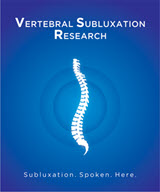Foundation for Vertebral Subluxation Issues Response to Rubicon Definition of Subluxation

On May 23, 2017, The Rubicon Group (TRG) issued a definition and position statement on the chiropractic subluxation. The definition states "We currently define a chiropractic subluxation as a self-perpetuating, central segmental motor control problem that involves a joint, such as a vertebral motion segment, that is not moving appropriately, resulting in ongoing maladaptive neural plastic changes that interfere with the central nervous system's ability to self-regulate, self-organize, adapt, repair and heal."
CLICK HERE FOR RUBICON PRESS RELEASE
The Foundation for Vertebral Subluxation (FVS) participated in the two meetings held in Melbourne and San Francisco where stakeholders were involved in discussing this proposed definition. The FVS expressed its serious concerns about the process and the conclusions before, during and following those meetings.
Rubicon purports to be a single unifying group for conservative, traditional chiropractic - unfortunately their definition serves only to alienate numerous practitioners, technique experts, scientists, and academics devoted to the scientific exploration and clinical management of vertebral subluxation.
In their release, Rubicon correctly notes that “Many of the past definitions do not provide a testable definition of chiropractic subluxation.” Unfortunately, the definition adopted by Rubicon fails to provide a testable, operational definition and is not congruent with the traditional, scientific, philosophical and artistic (technique) foundations of the chiropractic profession. Further to this, the TRG definition of chiropractic subluxation is not limited to vertebral subluxation. The Rubicon definition removes “vertebral” from the lexicon and expands the definition of chiropractic subluxation beyond the spine.
The Rubicon definition is a description of one putative neurobiological mechanism. It describes only one model of subluxation focused on joint motion and dysafferentation. Other models of vertebral subluxation are not addressed. These include, but are not limited to:
- Component models (There are several)
- Spinal degeneration model
- Nerve root compression model
- Neurodystrophic model
- Non-synaptic models
- Spinal cord tension model
- Semiconductor mode
- Axoplasmic flow model
- Segmental facilitation model
- Segmental neuropathy model
- Dysponesis model
- Autonomic dystonia model
Such models vary in their levels of scientific support. As such, they help identify knowledge gaps which need to be identified for future research. These neurobiological models are not mutually exclusive, and in a given patient, may be present singly or in various combinations.
Additionally, there are various technique based models which are described as:
- Segmental
- Postural
- Tonal
The definition adopted by Rubicon is limited to the segmental model only and leaves out every other technique model.
The definition adopted by Rubicon fails to provide a testable, researchable, operational definition even though TRG states this is one of the reasons for the definition. Assessments of vertebral subluxation should be reliable and valid, particularly if used in a research setting. Assessment of altered joint motion (the model proposed in the definition) poses challenges:
- The reliability of motion palpation is questionable. Most studies show it to be unreliable. For example, a systematic review of 44 articles reported that only eight reported relatively high levels of reproducibility, and only 4 of these were judged to be of acceptable quality.
- Videofluoroscopy may reliably demonstrate alterations of spinal joint motion, but requires a skilled examiner, appropriate equipment, and imposes a radiation burden that renders it unacceptable for routine pre- and post- adjustment assessments.
The argument that the problems facing the profession relative to the subluxation concept are that there is no single agreed upon definition is a Red Herring. There are numerous definitions and models of vertebral subluxation. As Lantz noted, “Common to all concepts of subluxation are some form of kinesiologic dysfunction and some form of neurologic involvement.” Further there are objective, valid and reliable methods to measure these and other components of vertebral subluxation. Taken in context with the totality of the literature there is, in fact, widespread agreement on vertebral subluxation.
The proposed definition by Rubicon discusses some possible ramifications of abnormal joint motion, but does not require an assessment of neurological function as part of the analysis. Thus, it fails as an operational definition.
The TRG contends that theirs is an “evidenced based definition” however, their contentions are poorly referenced, very limited and the literature chosen is biased toward only one model of chiropractic subluxation (theirs). The scientific research used to buttress the legitimacy of the definition is derived from studies that explore the common domain effects of spinal manipulative therapy on joint dysfunction and central neural function.
The fact that a multitude of interventions and daily activities beyond chiropractic may elicit similar responses on central neural function should highlight the danger and foolishness of adopting such a limited definition of the unique underpinnings of the chiropractic profession.
Making matters worse are the use of studies that equate the common domain procedure of spinal manipulation with the chiropractic adjustment and vertebral subluxation with joint dysfunction. This reveals a deep ignorance regarding nomenclature and definitions and it also departs from the historical and philosophical basis of vertebral subluxation theory.
An evidence-informed approach to vertebral subluxation requires, minimally:
- Reliable and valid assessments
- Biological plausibility
- External evidence
- Chiropractor’s knowledge and experience
- Patient preferences
- Congruence with chiropractic philosophy
- Health outcomes
The Foundation for Vertebral Subluxation has developed a Research Agenda focused on five areas:
- Research focused on the description and identification of the various operational models of vertebral subluxation.
- Research focused on the validity and reliability of measures to identify and characterize vertebral subluxation.
- Research on the epidemiology of vertebral subluxation including its incidence, prevalence, morbidity and mortality.
- Research on clinical strategies for preventing, arresting, reducing and correcting vertebral subluxations.
- Research on health outcomes following management of vertebral subluxation.
Given the nature of vertebral subluxation and the current knowledge base, the approach by the Foundation is inclusive rather than exclusive in terms of researching the various operational models. The proposed definition should be reconsidered. Any definition of vertebral subluxation, be it political, conceptual, or operational needs to be inclusive, rather than focused on a single model.
For all the reasons cited above the Foundation for Vertebral Subluxation cannot support or endorse the definition of subluxation adopted by the Rubicon Group and it is our opinion that the adoption of this definition by schools focused on training future generations of chiropractors in the location, analysis and correction of vertebral subluxation does not serve that purpose or mission.

Blogs
- The Chiropractic Cartel: A Look Back at Bias in Accreditation and its Imact on Today's Profession
- Inside Montana's Chiropractic Monopoly: ACA & MCA's Brazen Board Takeover
- Concerns Grow About Control of the NY State Chiropractic Board by the ACA - Use of X-ray in NY Under Threat
- Reproductive Health Information and Chiropractic Care: Navigating New Privacy Regulations
- Navigating Substance Use Disorder (SUD) Consent: What Chiropractors Need to Know













